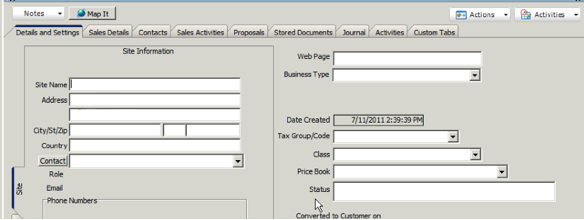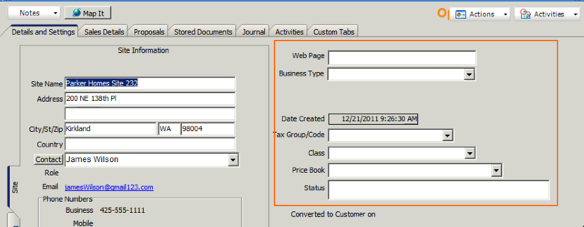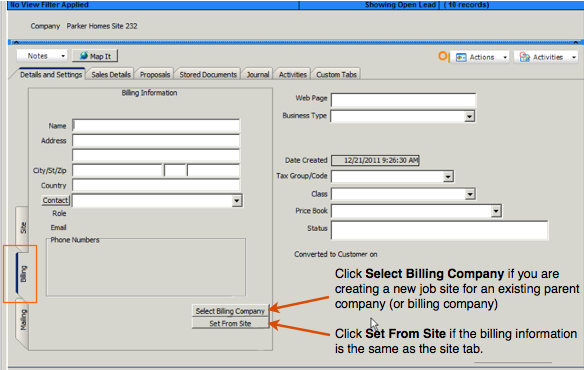Leads
You can track your sales prospects or potential customers in the Leads section of the Sales Module. Enter customer information and track sales information such as potential revenue, estimated close date, sales stage and more. When a lead becomes a customer, you can move the lead to the Customer module.
Lead Overview
A lead is a potential customer. A lead is separate from your customers and doesn’t sync to QuickBooks customers.
A lead can be converted to a customer. You can do this directly from the lead or the lead is automatically converted to a customer when you convert the proposal for the lead to a service order, install order, or invoice.
Create a New Lead
1. Go to Sales module > Leads
2. Click New and a blank lead record will open.
(You can also click New > Lead at the top of SME to start a new lead.)

3. On the Details and Setting tab, enter the Site Name, Address, City, and State.

4. Click the Contact button to enter the lead’s contact info such as email and phone number. Click OK in the Contact Editor window. To add more contact, click the Contact tab and click New.

5. Click the Billing tab. If the billing information is the same as the site information, click Set from site. This will populate the billing tab with the information from the site tab. If the Lead is a new job site for an existing billing company, instead of clicking Set from site, click Select Billing Company and in the search window select the parent company for the lead.
6. Fill out the rest of the Details and Settings tab if applicable.

Webpage - Enter your leads website
Business Type - This drop down field is customizable. It should reflect the different types of businesses you work with. If you are using this field, you can sort and filter your leads (and customers) by this field.
Tax Group/ Code- Assign the Tax Group / Code for the lead. When you convert the lead to a customer, the tax code will follow to the customer.
Class - If you are using classes, you can assign to the lead. Classes are created in QuickBooks and they allow you to classify income and expenses by department, business office or location, separate properties owned, or any other meaningful breakdown of a business. Because users can generate reports by class, the use of classes may be better than creating a large chart of accounts with separate subaccounts for each group.
Price Book - If you have an agreement with your lead to give them special prices on labor, services or material, you can assign the related Price Book. When the lead is converted to a customer, the price book will follow to the customer record. Click Price Books for more information.
Status - Text field for you to reference.
7. Click Save.
Sales Details tab
The Sales Details tab has fields you will want to use to track more details for your lead such as where the lead is in your sales process, when you estimate the lead to close, and the source of your lead. You can sort and filter your leads by any of these fields.

Salesperson - The user creating the lead will populate the Salesperson field.
Assigned to - You can assign the lead to another SME User
Compliance Code - If your lead would require techs that go on their job sit to pass specific certifications, you can assign a compliance code to the lead. Click Tech Compliance to read more.
Lead Source - Customize this drop down to reflect where you get your leads from. (Customize the drop down values in Setup module > Company > Lists.)
Sales Stage - This drop down should reflect the stages you move your leads through (e.g. Cold Lead, Qualified Lead, Needs Assessment, Presentation, Proposal, Refine Solution, etc. Customize the drop down values in Setup module > Company > Lists.)
Forecasted - Enter the potential revenue from this lead.
Percent - Enter the probability the lead will close
System -Used to designate major systems of inventory the lead would be using.
Last Action - After working with the lead, you can enter the last action date. In the search window you can sort your leads by this field and find the leads you haven't worked with in awhile.
Next Action - You can set a date you want to take action next. You can sort by this field in the search window. You will not be prompted to follow up by this field. If you want to be prompted, set an activity. Click Activities for more information.
Exp. Close Date - Set the date you are expecting the lead to close. You can sort by this field in the search window.
If there is something you want to track but you don't see it on this tab, you can create custom field. Custom fields can be text fields, drop downs, date fields and more. Click Custom Tabs and Fields to learn how to setup custom fields.
Add Notes
As you are working with your lead you will want to take notes on your phone calls or emails exchanged. There area couple ways for you to enter notes for your leads.
Journal Notes
Journal Notes allows you to enter notes that can be tagged by “type” and locked in once submitted. Users can enter journal notes with a note type, subject, and body. Once the notes are saved, they become permanent records.
To add a new note:

1. Click Notes > Add.
2. In the Journal Editor, select a Note Type.
3. Type your note in the window.
4. Click OK.
Once a note is entered, it is saved and cannot be edited.
View Note History
1. Click the Journal tab.
2. Double click on the note you want to read to open the journal note in a new window.

When you convert the lead to a customer, you will be able to reference all the notes entered in all the modules for the customer.
